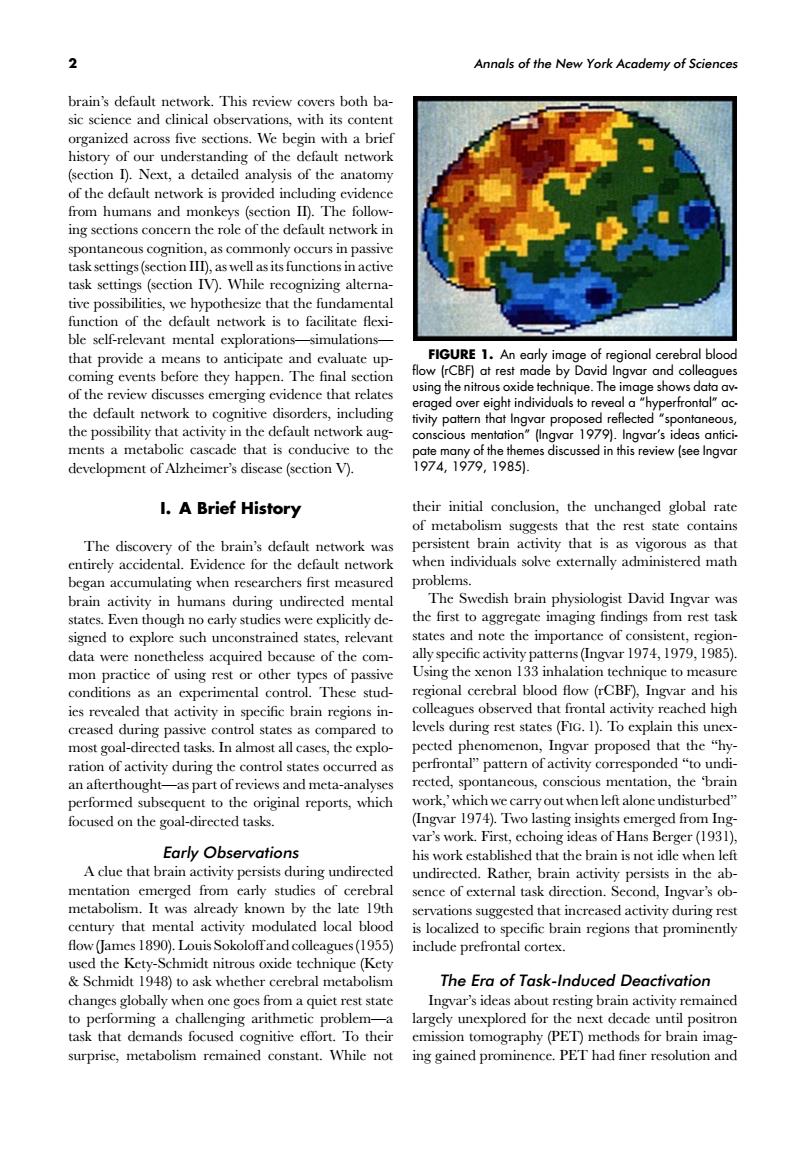正在加载图片...

2 Annals of the New York Academy of Science brain's default network.This review covers both ba sic science and clinical observations,with its content organized across five sections.We begin with a brief nalysis of the anatomy rn the role of the default rk in task settings(section IV).While recognizing alterna- tive possibilities,we hypothesize that the fundamental an 1 isto faciltate GuREl.Aheotinegeotfregonalcerebralblbod ents before they ha The final s gevidence that relates the default network to cognitive disorders,including ged over e the possibility that activity in the default network aug gvar'sonian ments a metabol cascade that is conducive to the development of Alzheimer's disease (section V). 7ATg7gh98gmesdcuadinthieiewege I.A Brief History mcta the brain's defaul suggests th e rest state conta when individuals solve externally administered math problems. brain activity in humans during undire ted menta The Swedish brain physiologist David Ingvar was states.Even though no early studies were explicitly de- the first to aggregate imaging findings from rest task signed to explore such unconstrained states,relevant tes and note the importance ot data were nonetheless acquired because of the com- 1974, rest o CBE I nd hi s observed that frontal activity reached high levels during rest states(FIG.1).To explain this une most goal-direeted tasks.In almost all cascs.the lo pected phenomenon,Ingvar proposed that the "h ration of activity during the control states occurred as perfrontal"pattern of activity corresponded"to und an afterthought- -as part of reviews and meta-analyses tancous,con 3101 performed subsequent to the original reports,which a one un fr urbe focused on the goal-directed task 1031 Early Observations his work established that the brain is not idle when lef A clue that brain activity persists during undirected undirected.Rather,brain activity persists in the ab sence of external task direction.Second,Ingvar's ob wa 19 vations suggested that increased activity during res /1055 sed the ket-Schmidt nitr Schmidt 1948)to ask whether cerebral metabolism The Era of Task-Induced Deactivation changes globally when one goes from a quiet rest state Ingvar's ideas about resting brain activity remained largely unexplored for the next decade until positron on tomography (PE 1) ds for ain imag ing gained promi had finer resolution an 2 Annals of the New York Academy of Sciences brain’s default network. This review covers both basic science and clinical observations, with its content organized across five sections. We begin with a brief history of our understanding of the default network (section I). Next, a detailed analysis of the anatomy of the default network is provided including evidence from humans and monkeys (section II). The following sections concern the role of the default network in spontaneous cognition, as commonly occurs in passive task settings(section III), aswell asitsfunctionsin active task settings (section IV). While recognizing alternative possibilities, we hypothesize that the fundamental function of the default network is to facilitate flexible self-relevant mental explorations—simulations— that provide a means to anticipate and evaluate upcoming events before they happen. The final section of the review discusses emerging evidence that relates the default network to cognitive disorders, including the possibility that activity in the default network augments a metabolic cascade that is conducive to the development of Alzheimer’s disease (section V). I. A Brief History The discovery of the brain’s default network was entirely accidental. Evidence for the default network began accumulating when researchers first measured brain activity in humans during undirected mental states. Even though no early studies were explicitly designed to explore such unconstrained states, relevant data were nonetheless acquired because of the common practice of using rest or other types of passive conditions as an experimental control. These studies revealed that activity in specific brain regions increased during passive control states as compared to most goal-directed tasks. In almost all cases, the exploration of activity during the control states occurred as an afterthought—as part of reviews and meta-analyses performed subsequent to the original reports, which focused on the goal-directed tasks. Early Observations A clue that brain activity persists during undirected mentation emerged from early studies of cerebral metabolism. It was already known by the late 19th century that mental activity modulated local blood flow(James 1890). Louis Sokoloff and colleagues(1955) used the Kety-Schmidt nitrous oxide technique (Kety & Schmidt 1948) to ask whether cerebral metabolism changes globally when one goes from a quiet rest state to performing a challenging arithmetic problem—a task that demands focused cognitive effort. To their surprise, metabolism remained constant. While not FIGURE 1. An early image of regional cerebral blood flow (rCBF) at rest made by David Ingvar and colleagues using the nitrous oxide technique. The image shows data averaged over eight individuals to reveal a “hyperfrontal” activity pattern that Ingvar proposed reflected “spontaneous, conscious mentation” (Ingvar 1979). Ingvar’s ideas anticipate many of the themes discussed in this review (see Ingvar 1974, 1979, 1985). their initial conclusion, the unchanged global rate of metabolism suggests that the rest state contains persistent brain activity that is as vigorous as that when individuals solve externally administered math problems. The Swedish brain physiologist David Ingvar was the first to aggregate imaging findings from rest task states and note the importance of consistent, regionally specific activity patterns(Ingvar 1974, 1979, 1985). Using the xenon 133 inhalation technique to measure regional cerebral blood flow (rCBF), Ingvar and his colleagues observed that frontal activity reached high levels during rest states (FIG. 1). To explain this unexpected phenomenon, Ingvar proposed that the “hyperfrontal” pattern of activity corresponded “to undirected, spontaneous, conscious mentation, the ‘brain work,’whichwe carry outwhen left alone undisturbed” (Ingvar 1974). Two lasting insights emerged from Ingvar’s work. First, echoing ideas of Hans Berger (1931), his work established that the brain is not idle when left undirected. Rather, brain activity persists in the absence of external task direction. Second, Ingvar’s observations suggested that increased activity during rest is localized to specific brain regions that prominently include prefrontal cortex. The Era of Task-Induced Deactivation Ingvar’s ideas about resting brain activity remained largely unexplored for the next decade until positron emission tomography (PET) methods for brain imaging gained prominence. PET had finer resolution and